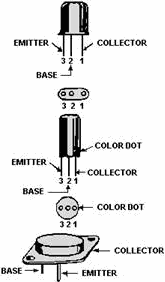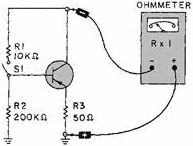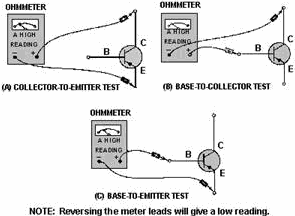Module 7 - Introduction to Solid-State Devices and Power Supplies
Pages i ,
1-1,
1-11,
1-21,
1-31,
1-41,
2-1,
2-11,
2-21,
2-31,
2-41,
2-51,
3-1,
3-11,
3-21,
3-31,
3-41,
3-51,
4-1 to 4-10,
4-11,
4-21,
4-31,
4-41,
4-51, Index
 A Transistor Gain Test can be made using an ohmmeter and a simple test circuit. The
principle behind this test lies in the fact that little or no current will flow in a transistor between emitter
and collector until the emitter-base junction is forward biased. A 10-to-1 resistance ratio in the test
between meter readings indicates normal gain.

Transistor JUNCTION Resistance Test can also be made using an ohmmeter by measuring
the base-emitter, base-collector, and collector-emitter forward and reverse resistances.
2-51

MICROELECTRONICS is a broad term used to describe the use of integrated circuits to
miniaturize electronic equipment. A PRINTED Circuit BOARD (PCB) is a flat, insulating
surface upon which printed wiring and miniaturized components are connected in a predetermined design and attached
to a common base. MODULAR CircuitRY is an assembly technique in which printed circuit
boards are stacked and connected together to form a module. This technique increases the packaging density of
circuit components and results in a considerable reduction in the size of electronic equipment. An
INTEGRATED Circuit is a device that integrates (combines) both active components (transistors, diodes,
etc.) and passive components (resistors, capacitors, etc.) of a complete electronic circuit in a single chip.

The two basic types of ICs are the HYBRID and the MONOLITHIC.
In the MONOLITHIC IC, all elements (resistors, transistors, etc.) associated with the circuit are
fabricated inseparably with a continuous piece of material (called the substrate).
2-52
In the HYBRID IC, the passive components (resistors, capacitors) are deposited onto a
substrate (foundation) made of glass, ceramic, or other insulating material. Then the active components (diodes,
transistors) are attached to the substrate and connected to the passive components using fine wire.
Answers to Questions Q1. Through Q42. A1. Transistor A2. Amplification. A3. Outward. A4. Point-contact.
A5. Quality control. A6. Positive, more positive. A7. Because the N material on one side of
the forward-biased junction is more heavily doped than the P-material. A8. The P or base section.
A9. 98 percent. A10. Holes. A11. The polarity of voltage applied to the PNP transistor is
opposite of that applied to the NPN transistor A12. I B.
A13. The base current loop and the collector current loop. A14. Amplifier.
A15. Compensation for slight variations in transistor characteristics and changes in transistor conduction
because of temperature variations. A16. The signals are opposite in polarity or 180 degrees out of phase
with each other. A17. The polarity of the source voltage. A18. Base current bias or fixed
bias. A19. Self-bias. A20. When it is necessary to prevent amplitude distortion.
A21. The voltage-divider type. A22. Class A. A23. Cutoff.
2-53
A24. The amount of bias and the amplitude of the input signal. A25. Class A.
A26. Common emitter (CE), common base (CB), and common collector (CC).
A27. Common emitter. A28. Base current (I B). A29. Alpha (a). A30. Common base.
A31. IE. A32. Common collector. A33. 
A34. The kind of transistor, the transistor's common applications, and mechanical data. A35. The
number of junctions in the device, which in this case indicates a transistor. A36. Heat.
A37. The substitution method. A38. The power must be removed from the circuit.
A39. By the wide space between the collector lead and the other two leads (emitter and base).
A40. Gain and junction resistance. A41. Normal gain. A42. a leaking transistor
2-54
| - |
Matter, Energy,
and Direct Current |
| - |
Alternating Current and Transformers |
| - |
Circuit Protection, Control, and Measurement |
| - |
Electrical Conductors, Wiring Techniques,
and Schematic Reading |
| - |
Generators and Motors |
| - |
Electronic Emission, Tubes, and Power Supplies |
| - |
Solid-State Devices and Power Supplies |
| - |
Amplifiers |
| - |
Wave-Generation and Wave-Shaping Circuits |
| - |
Wave Propagation, Transmission Lines, and
Antennas |
| - |
Microwave Principles |
| - |
Modulation Principles |
| - |
Introduction to Number Systems and Logic Circuits |
| - |
- Introduction to Microelectronics |
| - |
Principles of Synchros, Servos, and Gyros |
| - |
Introduction to Test Equipment |
| - |
Radio-Frequency Communications Principles |
| - |
Radar Principles |
| - |
The Technician's Handbook, Master Glossary |
| - |
Test Methods and Practices |
| - |
Introduction to Digital Computers |
| - |
Magnetic Recording |
| - |
Introduction to Fiber Optics |
| Note: Navy Electricity and Electronics Training
Series (NEETS) content is U.S. Navy property in the public domain. |
|













